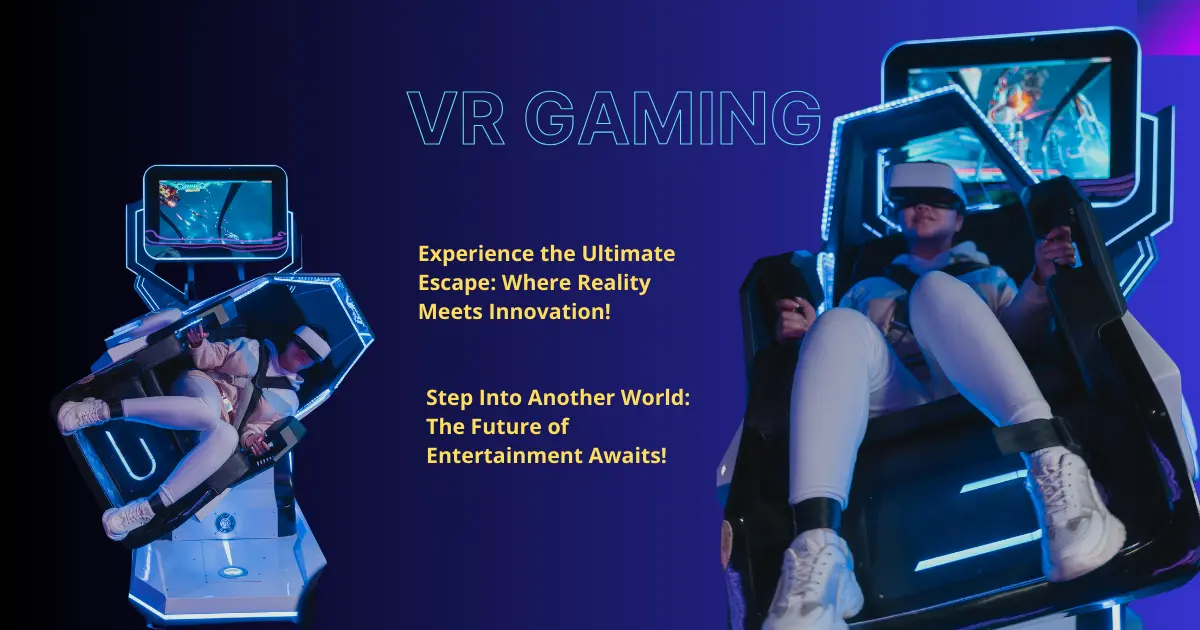The Remarkable Power of VR Gaming: A New Era in Immersive Entertainment

Virtual Reality (VR) gaming is revolutionizing the entertainment industry by offering immersive experiences that transport players into fully interactive digital worlds. From its origins as a niche concept in science fiction, VR gaming has evolved into a multi-billion-dollar industry, transforming how we engage with games. This innovative technology allows users to enter virtual environments and interact with digital objects and scenarios in ways that were once considered impossible.
The VR gaming market has witnessed explosive growth over the last decade, driven by technological advancements and a growing demand for more engaging gaming experiences. Devices like the Meta Quest Pro and Apple Vision Pro have taken immersion to new heights, enabling gamers to experience digital worlds with unprecedented realism. The global VR gaming market was valued at $11.56 billion in 2022 and is projected to grow to $62.1 billion by 2030, with a CAGR of 23.8%. Moreover, VR gaming is no longer limited to enthusiasts; it is becoming more mainstream, reaching audiences across diverse demographics.
This article explores the evolution of VR gaming, how it works, the most popular devices and platforms, the genres benefiting the most, the benefits of VR gaming, the challenges it faces, and the trends shaping its future. Together, these aspects paint a vivid picture of an industry poised for even greater innovation and growth.
Table of Contents
1. How VR Works in Gaming
The core of VR gaming lies in its ability to create a simulated environment where users feel physically present. This level of immersion is achieved through the integration of multiple technologies, each contributing to the overall experience. Key components of VR gaming include:
- VR Headsets: These devices serve as the gateway to virtual worlds. Advanced headsets such as the Meta Quest Pro, Apple Vision Pro, and Sony PlayStation VR2 deliver high-resolution visuals that fully encompass the player’s field of vision. Features like 360-degree imagery and eye-tracking enhance realism.
- Controllers and Sensors: Motion-tracking controllers, like those accompanying the Valve Index VR Kit and HTC Vive Pro, allow players to interact with virtual objects seamlessly. Sensors track the player’s movements and replicate them within the game environment, creating an intuitive and engaging experience. Over 60% of VR users in 2023 reported using VR headsets primarily for gaming.
- Haptic Feedback: By providing tactile sensations, haptic feedback technologies, often integrated into VR controllers, help players “feel” their interactions. For example, a vibration might simulate the impact of a sword strike or the recoil of a gun.
The synergy of these elements transforms traditional gaming into an immersive adventure. As technology evolves, new features like spatial audio and advanced motion tracking are set to further enhance the VR experience.
2. Popular VR Gaming Platforms and Devices
The VR gaming landscape is defined by a variety of platforms and devices, each offering unique features and capabilities. Here’s a closer look at some of the most popular options:
- Meta Quest Pro: As a standalone headset, the Meta Quest Pro offers a portable and high-performance option for gamers. Its advanced processors and high-resolution display make it one of the most versatile headsets on the market. Oculus devices, including the Meta Quest Pro, accounted for approximately 46% of all VR headset sales in 2023.
- Apple Vision Pro: This cutting-edge device blends augmented and virtual reality to deliver a groundbreaking experience. Its integration with the Apple ecosystem and premium build quality have positioned it as a leader in immersive technology.
- Sony PlayStation VR2: Tailored for PlayStation consoles, the Sony PlayStation VR2 combines affordability with excellent performance. Its seamless integration with PlayStation’s ecosystem ensures a smooth and enjoyable experience for console gamers.
- Valve Index VR Kit: Known for its ergonomic controllers and high-fidelity visuals, the Valve Index VR Kit caters to serious gamers and developers. Its precise motion tracking and immersive audio make it a top choice for high-end gaming.
- HTC Vive Pro: With its versatility and professional-grade features, the HTC Vive Pro is favored by both gamers and developers. Its customizable settings and robust performance make it ideal for extended sessions and complex applications.
Each of these platforms meets the needs of different audiences, from casual players to professional developers. Together, they showcase the diverse and rapidly evolving nature of the VR gaming market.


3. Genres of Games Enhanced by VR
VR gaming has breathed new life into various genres, offering unique experiences that are impossible to replicate in traditional gaming formats. Some of the most impactful genres include:
- Action and Adventure: VR brings unparalleled immersion to action and adventure games. Titles like Half-Life: Alyx leverage VR’s capabilities to deliver heart-pounding combat and exploration. Players can physically dodge attacks, interact with the environment, and feel the intensity of the action.
- Simulation and Sports: VR excels in simulation and sports games, creating realistic environments where players can practice real-world skills or enjoy physical activity. Games like Beat Saber combine rhythm and movement, offering an engaging way to stay active. Studies show that 30 minutes of VR fitness games can burn between 200-300 calories, making them as effective as moderate-intensity physical exercise.
- Puzzle and Storytelling: Story-driven games such as The Room VR utilize the immersive qualities of VR to captivate players with intricate puzzles and compelling narratives. These games create a sense of presence that draws players deeper into the story.
By enhancing these genres, VR gaming offers diverse experiences that cater to a wide range of player preferences. The ability to interact physically and emotionally with games has elevated the entertainment value and depth of these genres.
4. The Benefits of VR Gaming
The appeal of VR gaming extends beyond entertainment, offering a range of benefits that impact players physically, mentally, and socially:
- Enhanced Immersion: VR gaming creates an unparalleled sense of presence, allowing players to step into the shoes of characters and engage with digital worlds on a personal level. This level of immersion makes games more impactful and memorable.
- Physical Activity: Many VR games require players to move, promoting physical fitness. Games like Superhot VR and BoxVR offer fun ways to exercise while enjoying an engaging gaming experience.
- Therapeutic Applications: VR is increasingly used in therapy, helping users manage anxiety, PTSD, and phobias. The immersive environments allow for controlled exposure and practice in a safe setting.
- Educational Value: VR simulations are revolutionizing education and training. From medical procedures to flight training, VR provides hands-on learning experiences that are both effective and engaging.
These benefits highlight the transformative potential of VR gaming, extending its impact beyond traditional entertainment.
5. Challenges Facing VR Gaming
Despite its many advantages, VR gaming faces several challenges that must be addressed for the industry to thrive:
- High Costs: The advanced technology behind devices like the Apple Vision Pro and Meta Quest Pro makes them expensive, limiting accessibility for many potential users. The average cost of high-end VR headsets in 2023 ranged between $400 and $1,200.
- Motion Sickness: Some players experience discomfort due to the disconnect between visual motion and physical sensation. This remains a significant barrier to widespread adoption. 50-70% of VR users report some degree of motion sickness.
- Content Limitations: While the library of VR games is growing, it still lags behind traditional gaming platforms in terms of variety and depth. Developers face high costs and technical challenges in creating VR content.
Addressing these challenges will be crucial to ensuring the continued growth and success of VR gaming as a mainstream form of entertainment.
6. Future Trends in VR Gaming
The future of VR gaming is filled with exciting possibilities, driven by advancements in technology and increasing interest in immersive experiences:
- Hardware Advancements: The next generation of VR headsets, like the Valve Index VR Kit and HTC Vive Pro, promise improved comfort, resolution, and affordability. These innovations will make VR more accessible and appealing to a broader audience.
- Integration with AI: AI-driven technologies will enable more dynamic and interactive gaming experiences. Intelligent NPCs and adaptive gameplay will make virtual worlds feel more alive and responsive.
- Cross-Platform Compatibility: Devices like the Sony PlayStation VR2 are paving the way for seamless integration across consoles, PCs, and mobile platforms, enhancing accessibility and convenience.
- Metaverse Expansion: As the metaverse evolves, VR gaming is expected to play a central role. The metaverse, largely driven by VR and AR, is expected to create a market opportunity of $800 billion by 2030. Shared virtual spaces for gaming, socializing, and commerce will redefine how we interact with digital environments.
These trends underscore the limitless potential of VR gaming to transform entertainment and beyond.
Conclusion
VR gaming has come a long way from its conceptual roots to becoming a cornerstone of modern entertainment. By offering unmatched immersion, physical engagement, and diverse applications, VR gaming has carved a niche that continues to expand. Devices like the Meta Quest Pro, Apple Vision Pro, and Sony PlayStation VR2 have set new standards for what’s possible in gaming.
While challenges such as cost and accessibility persist, ongoing technological advancements and growing interest in immersive experiences signal a bright future. For gamers and developers alike, VR gaming represents not just a new way to play but a revolutionary shift in how we experience virtual worlds. As VR technology evolves, its potential to redefine entertainment, education, and therapy will only grow. The era of VR gaming is here—and it’s only just beginning.






